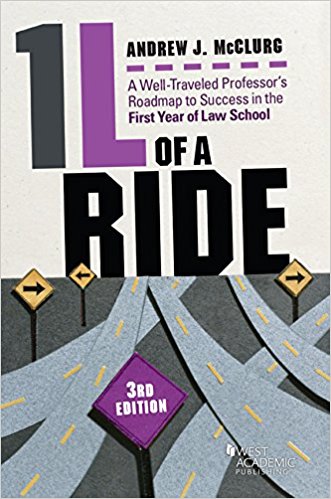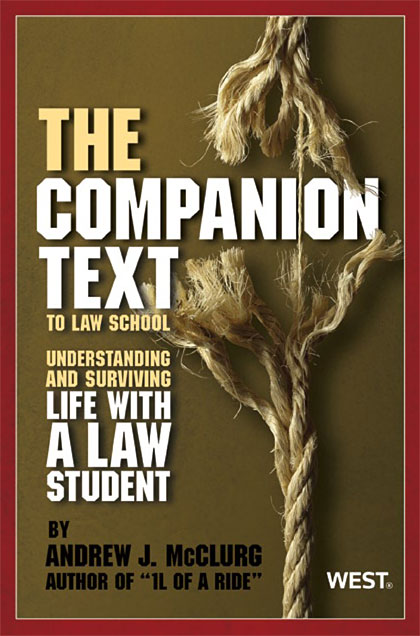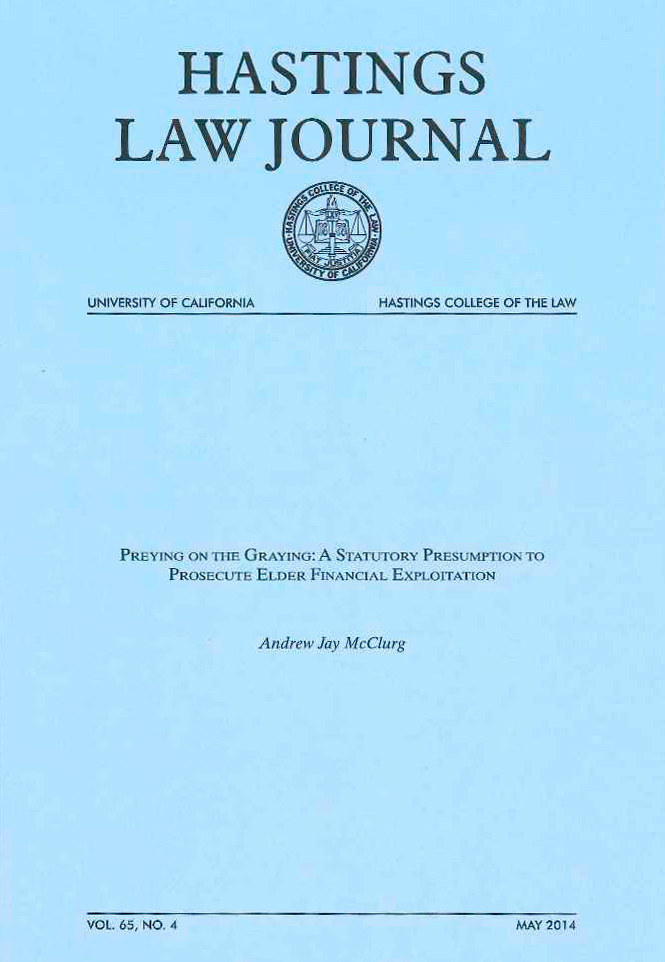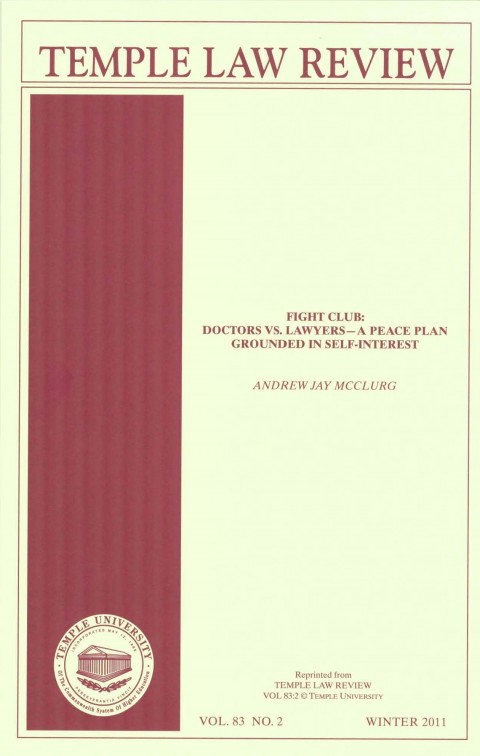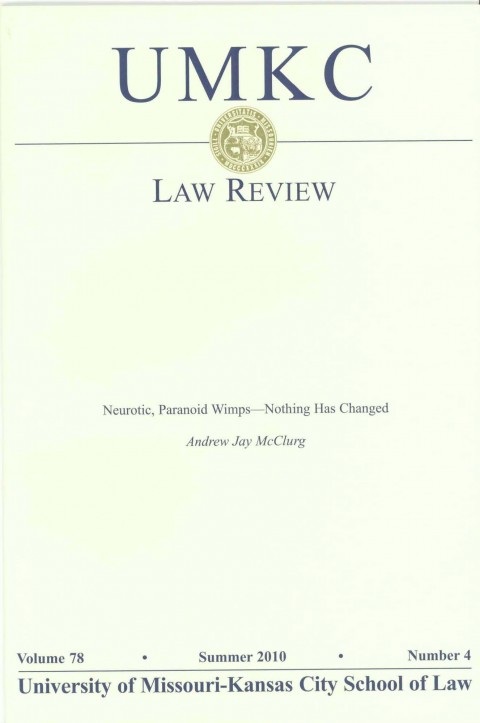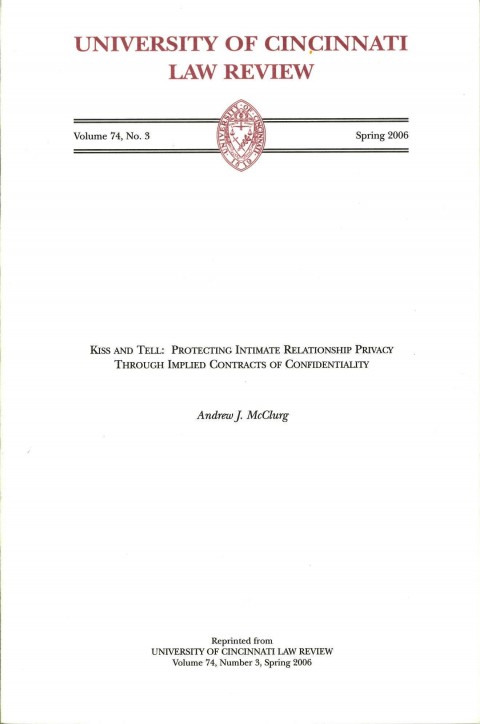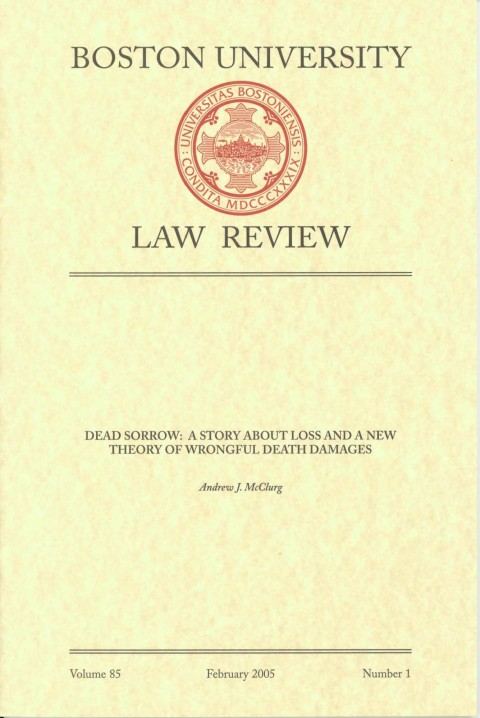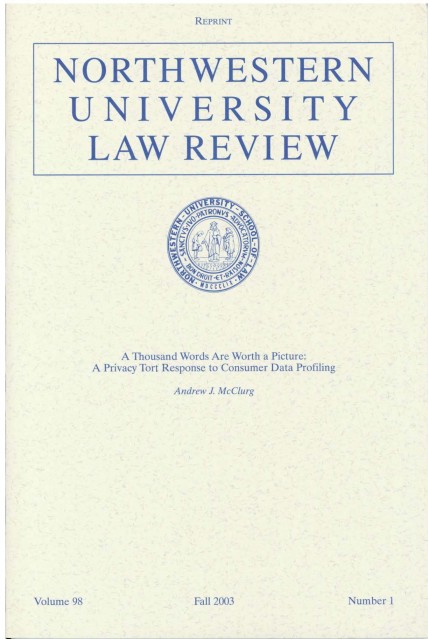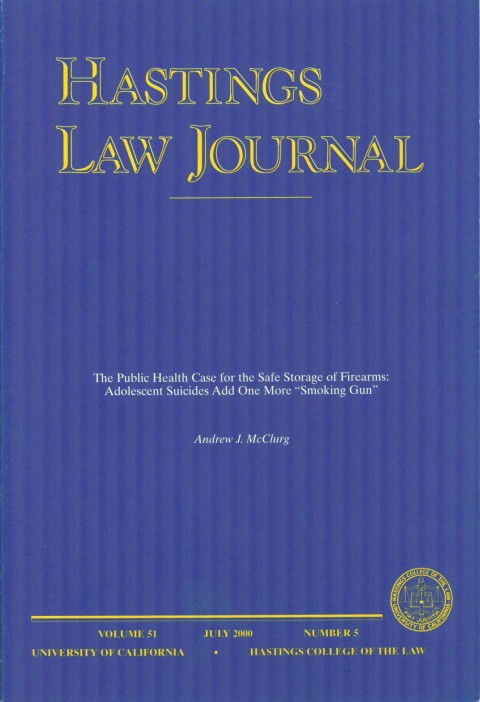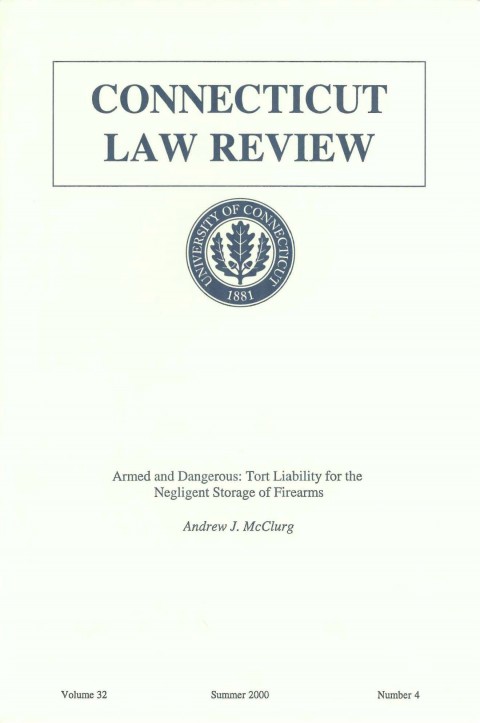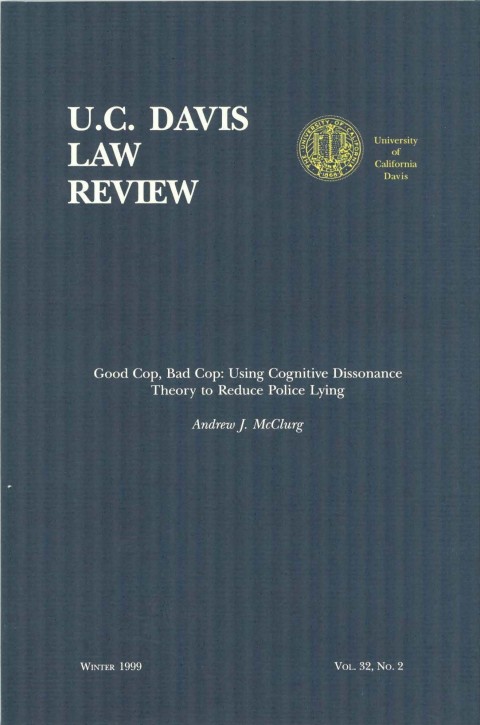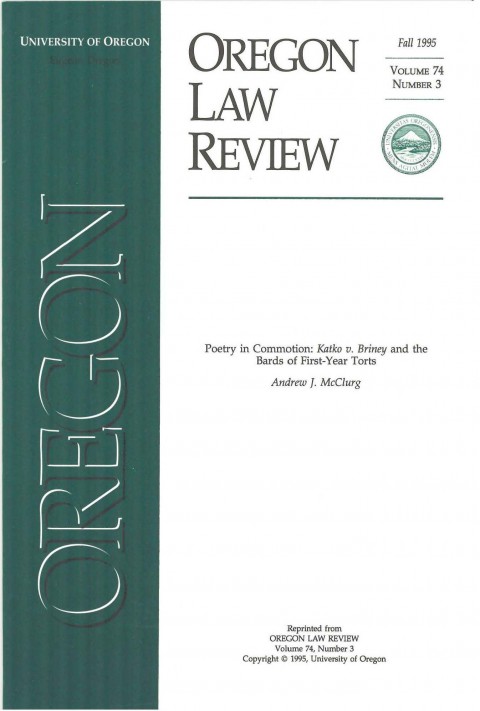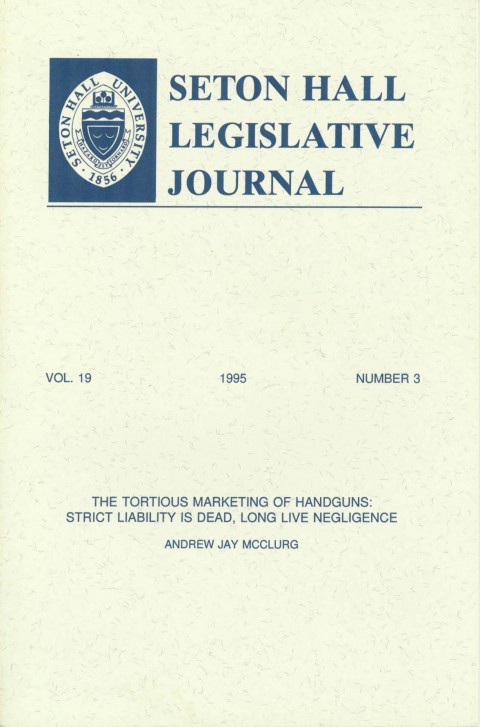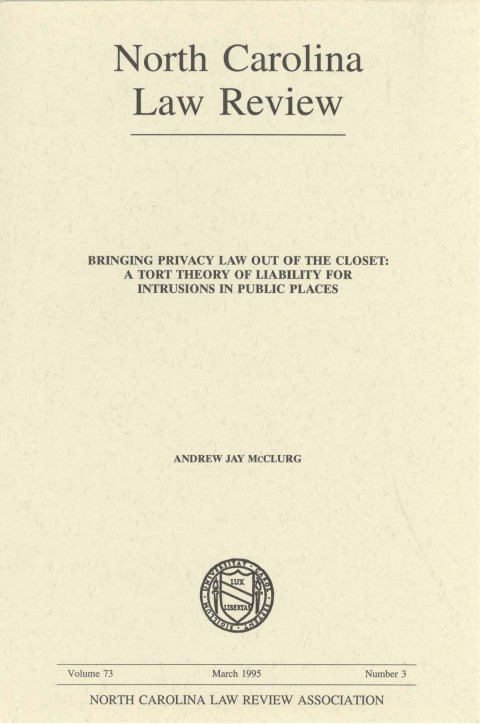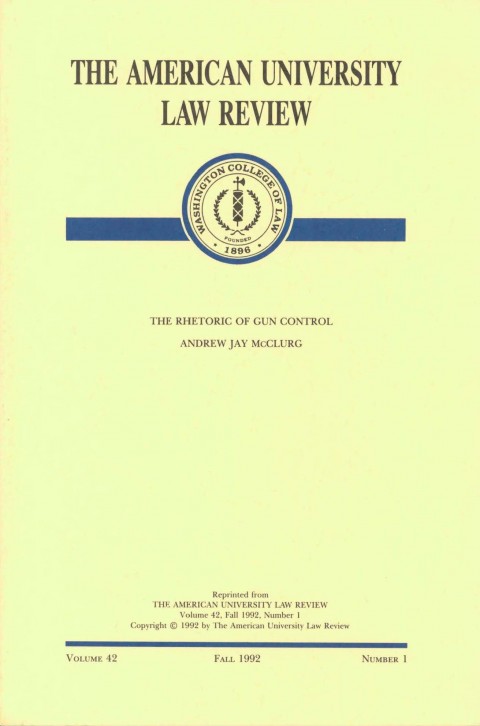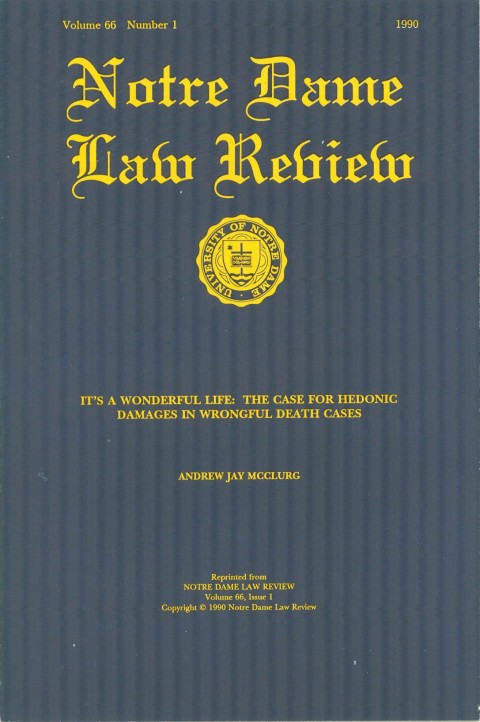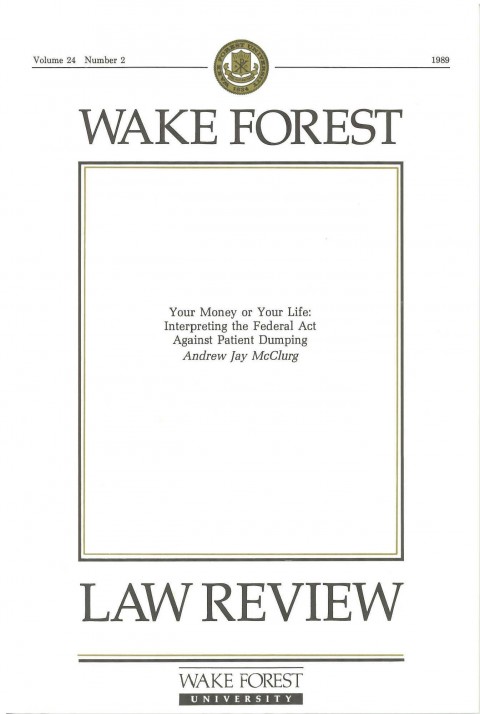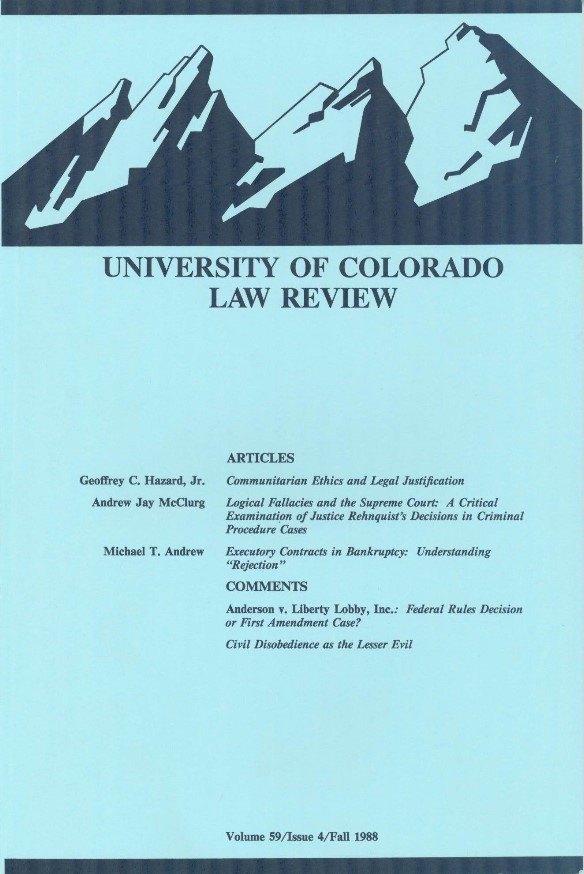April 15th, 2024 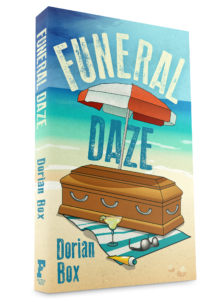 McClurg’s fifth novel, Funeral Daze, under his pen name Dorian Box, is out and getting terrific reviews. Check it out on Amazon. McClurg’s fifth novel, Funeral Daze, under his pen name Dorian Box, is out and getting terrific reviews. Check it out on Amazon.
Praise For McClurg’s (aka Dorian Box) Latest Novel
“FUNERAL DAZE by Dorian Box manages to be laugh-out-loud funny, heartwarmingly tender, and full of lively action and suspense, all at once—a thoroughly entertaining and engaging read.” — IndieReader (5 Stars; IR Seal of Approval)
“Funeral Daze is a novel that takes both light and dark elements to present a fantastically engaging, emotionally resonant story in a deeply humorous and satirical fashion. Unmissable reading.” — 2023 Readers’ Favorite Silver Medal for Humor Fiction)
“A hilarious page-turner that effortlessly blends crime, humor and South Florida beach culture. … Award-winning author Dorian Box (Psycho Tropics, The Hiding Girl) has always employed brilliant doses of well-timed levity in crime fiction, but he pulls out all the stops for this laugh-out-loud caper.” — BestThrillers
“The story unfolds at a crisp and steady pace, with plenty of thought-provoking moments once 12-year-old Jessica enters the scene, offering Danny surprisingly mature reflections on tragedy and a knockout mystery to occupy his time. … Funeral Daze delivers an appealing spin on the mystery genre through rich characterization and an abundance of insight throughout.” — Publishers Weekly BookLife Prize Seminfinalist
“A perfect beach read, this zany mystery has the thrills, quirky characters, juicy plot twists, and gripping conclusion you’re looking for!” — Reedsy Discovery
“Time and again, Box has proven he can write a tense thriller that is funny, dark, and completely endearing. It’s the perfect combination of a smart storyline and characters that keep you reading well after bedtime. Fantastic!” — NetGalley
“Funeral Daze is a macabre and hilarious novel that intersects the lives of several bizarre and oddly compelling characters. … Dorian Box masterfully directs the story into a series of unpredictable and uproarious events that are deliciously ironic, unexpectedly thought-provoking, and always edgy and dark.” — D. Donovan, Senior Reviewer, Midwest Book Review
And don’t forget McClurg’s (Box’s) other award-winning novels.
October 10th, 2019 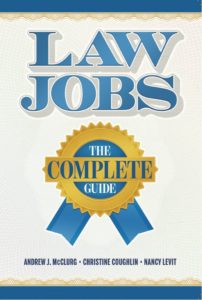 After two years of extensive research that included interviewing more than 150 lawyers, my new book (with coauthors Chris Coughlin and Nancy Levit), Law Jobs: The Complete Guide, has been published by West Academic Publishing. Here’s a description: After two years of extensive research that included interviewing more than 150 lawyers, my new book (with coauthors Chris Coughlin and Nancy Levit), Law Jobs: The Complete Guide, has been published by West Academic Publishing. Here’s a description:
Choosing a legal career that fits a student’s personality, skillset, and aspirations is the most important and difficult decision a law student faces, yet only a small number of law schools incorporate career-planning into their curriculums. Law Jobs: The Complete Guide seeks to help fill the gap. Law Jobs is a comprehensive, reader-friendly guide to every type of legal career. Packed with authoritative research and featuring comments from more than 150 lawyers who do the jobs, Law Jobs offers for each career general background, pros and cons, day in the life descriptions, and information about job availability, compensation, prospects for advancement, diversity, and how students can best position themselves for opportunities. Covered jobs include:
• Large and Medium-Sized Law Firms
• Small Firms and Solo Practitioners
• In-House and Other Corporate Counsel
• Government Agency Lawyers
• Non-Governmental Public Interest Law
• Prosecutors and Public Defenders
• Private Criminal Defense
• JD Advantage Jobs
• Contract (Freelance) Lawyering
• Judges, Mediators, and Arbitrators
• Judicial Law Clerks
• Legal Academic Jobs
Other chapters address lawyer happiness, the rapidly changing face of the legal profession due to technology and other forces, the division between litigation and transactional law, and the Top 50 legal specialty areas.
Together, the authors have received more than thirty awards for teaching and research, and have written extensively about law students and lawyers in books such as 1L of a Ride (McClurg), A Lawyer Writes (Coughlin), and The Happy Lawyer (Levit).
I got the idea for Law Jobs after reading too much about lawyer unhappiness and making the connection that many lawyers simply have not found their right place in the legal world. Too many law students do no serious career-planning at all, instead resigning themselves to take whatever job comes along. But it’s far too important a decision to leave to chance.
There is no single right or wrong job for everyone because we’re all different. Students need to know themselves—their skillset, personality types, and true aspirations. Only then can they find the best job fit. We think our book does a good job of providing information to help students identify the careers most likely to lead to their long-term happiness.
June 16th, 2017 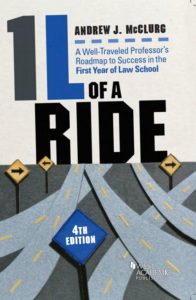 1L of a Ride: A Well-Traveled Professor’s Roadmap to Success in the First Year of Law School (West 4th ed. 2021) 1L of a Ride: A Well-Traveled Professor’s Roadmap to Success in the First Year of Law School (West 4th ed. 2021)
Amazon.com listing
Assigned as recommended or required reading at law schools throughout the country, 1L of a Ride provides a step-by-step navigational guide to both academic and emotional success in law school’s crucial first year.
Covered topics in the newly updated fourth edition include: top student fears, the first-year curriculum, effective class participation, types of law students and professors, case-briefing, note-taking, course-outlining, legal research and writing, exam preparation, essay and multiple-choice exam strategies, stress management, the impact of law school on outside relationships, special challenges faced by part-time and nontraditional students, online learning, career planning, and much more.
Shows rather than tells with dozens of anecdotes and comments from real law students, as well as authentic samples of Socratic dialogue, exam questions, student case briefs, class notes, and course outlines.
The only law school success book that:
• Addresses each aspect of academic success.
• Includes both a professor and student perspective, with comments from real law students as they progressed through their first year from beginning to end.
• Features real samples of Socratic dialogue, student case briefs, student class notes, and exam questions and answers.
• Focuses on practical advice that can be followed by any student from day one.
• Employs a lively first-person voice, humor, and dozens of anecdotes to bring the advice to life.
• Relies on educational research to back up advice.
• Includes input from other law professors, including an interview with five professors of Legal Writing, the course that causes the most angst and complaints from first-year students.
Review Excerpts:
“As a pre-law adviser I’ve read many books about preparing for law school or what to expect in the first year. This is by far the best!”
“[As the pre-law advisor at a California university,] I’d be surprised if anyone ever writes a better book on this topic. If it’s not yet the gold standard, it will be in the near future.”
“This book should be required by law schools as a guide to success. I could not have made it through without it!”
“If you read 1L of a Ride, trust me, you will have an edge over any student who hasn’t read it. There is a reason Professor McClurg has won numerous teaching awards and other accolades from the legal community. … When reading this book, you feel like you are getting honest, personal advice from a trusted friend. Along with advice about how to manage your first year mentally and emotionally, you learn skills such as case-briefing and effective note-taking that you will need on day one. And in law school, day one counts!”
“When I asked a friend and recent law school graduate how I should prepare for law school, she laughed and said, ‘Nothing can prepare you for law school.’ She was wrong. This book is an indispensable tool for anyone considering law school or already committed to law school. I call it a tool because it really is―it is an instrument used to achieve success in law school. It is a reference guide to utilize during the entire first year.”
“This book should be required by law schools as a guide to success. I could not have made it through without it! Included in the humorous, well-crafted text is a map through the misconceptions which all law students spend too much of their valuable first year trying to correct. Most students waste thousands of dollars during the first year just trying to get acclimated to the law school experience. Spend a few bucks on this book, start a step ahead, and get more from your investment.”
“Law schools should provide a copy of this book with each acceptance letter.”
“This book is a tour de force …. If you want to do more than survive―if you want to thrive―in law school, buy this book.”
August 25th, 2016 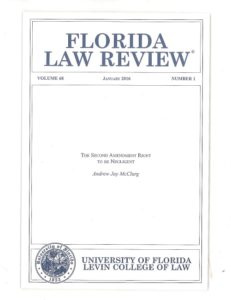 Andrew Jay McClurg, The Second Amendment Right to be Negligent, 68 Florida Law Review 1 (2016). Andrew Jay McClurg, The Second Amendment Right to be Negligent, 68 Florida Law Review 1 (2016).
Only two constitutional rights — the First and Second Amendments — have the capacity, through judicial interpretation or legislative action or inaction, to confer a “right to be negligent” on private citizens; that is, a right to engage in objectively unreasonable risk-creating conduct without legal consequences. In the First Amendment context, for example, the Supreme Court, in New York Times v. Sullivan and its progeny, expressly embraced a right to be negligent in defaming public officials and public figures to protect speech. This Article asserts that through both common and statutory law the United States has enshrined a de facto Second Amendment right to be negligent in many aspects of making, distributing, and possessing firearms, the only legal product designed to inflict what the tort system is designed to prevent.
Explaining that it is a microcosm of a much larger issue, the Article focuses on one area: allowing access to guns by criminals through theft. Hundreds of thousands of guns are stolen each year from individuals and commercial sellers. By definition, they all go directly to criminals. A substantial percentage of guns used in crime were previously stolen. Nevertheless, the common law has conferred near complete immunity on gun owners and sellers who fail to secure guns from theft when they are subsequently used to cause harm. This occurs despite frequent judicial pronouncements that the risk of firearms demands the highest degree of care in their use and keeping. To accomplish this result, courts ignore or mischaracterize fundamental scope of liability principles, rarely even reaching the question of whether reasonable care was exercised.
On the statutory front, not only have Congress and most states failed to mandate firearms security measures, Congress has — in the name of the Second Amendment — given express protection of the right to be negligent, most prominently in the form of the Protection of Lawful Commerce in Arms Act. The Act immunizes manufacturers and sellers of guns from most tort claims, including claims against commercial firearms licensees for negligent security leading to theft.
The Article argues that this government-endorsed lack of responsibility results in the under-deterrence of risky conduct that, with reasonable alterations, could avoid substantial intentional and accidental injury costs.
August 8th, 2016 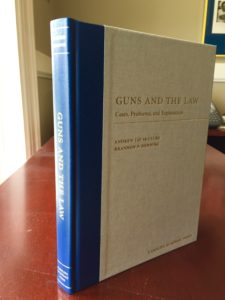 My new casebook–Guns and the Law: Cases, Problems, and Explanation–composed with Professor Brannon Denning, just came out. Featuring cases, problems, and explanation, it offers a balanced treatment of gun law and policy in the United States, which is hard to find in this highly charged area. My new casebook–Guns and the Law: Cases, Problems, and Explanation–composed with Professor Brannon Denning, just came out. Featuring cases, problems, and explanation, it offers a balanced treatment of gun law and policy in the United States, which is hard to find in this highly charged area.
Here’s the catalog description from Carolina Academic Press:
McClurg (pro-reasonable regulation) and Denning (pro-gun-rights) apply their decades of experience studying firearms policy and gun violence in this balanced, reader-friendly casebook addressing the contentious issues of guns in America. Through cases, problems, and provocative notes and questions, the book explores current federal and state gun laws, major constitutional cases, post-Heller Second Amendment litigation, modern self-defense rules such as Stand Your Ground laws, civil liability, gun laws in other countries, legal solutions to gun violence, and issues of guns and race, alienage, culture, and gender.
We designed the book to be accessible not only to law professors and law students, but to undergraduate and other graduate school professors. Professors interested in teaching a course in the area can obtain a complimentary copy from the publisher.
February 19th, 2016 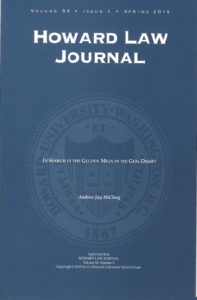 Andrew Jay McClurg, In Search of the Golden Mean in the Gun Debate, 58 Howard Law Journal 779-809 (2015). Andrew Jay McClurg, In Search of the Golden Mean in the Gun Debate, 58 Howard Law Journal 779-809 (2015).
The American gun debate is stuck and has been for a long time. Both sides remain trapped by their own hyperbolic rhetoric and reasoning fallacies, with the result that partisans are being heard only by those who already agree with them. This essay asserts that there is such a thing as “reasonable middle ground” in the gun debate and seeks to prove it by analyzing five specific measures that have the potential to reduce gun violence without infringing legitimate Second Amendment rights:
(1) bolstering federal support for research into the causes and prevention of gun violence, which Congress has blocked since the 1990s;
(2) extending instant background checks, currently required only for sales by licensed firearms dealers, to all gun sales;
(3) requiring gun purchasers to demonstrate their knowledge of state gun laws and basic gun safety rules and also their ability to safely handle the gun they are purchasing;
(4) mandating security measures by retail gun sellers to prevent theft; and
(5) implementing microstamping technology that would enable law enforcement to trace crime guns and ammunition cartridges found at crime scenes, facilitating the apprehension and prosecution of violent criminals.
While more substantial measures would be more effective in combating gun deaths and injuries, this essay purposely selected limited measures with the hopeful goal of getting people to recognize that there may well be middle-ground or a “golden mean” in the gun debate.
September 12th, 2013 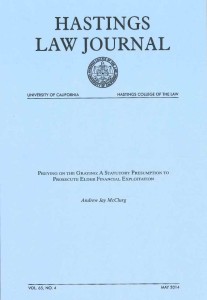 Andrew Jay McClurg, Preying on the Graying: A Statutory Presumption to Prosecute Elder Financial Exploitation, 65 Hastings Law Journal 1099-1144 (2014). Andrew Jay McClurg, Preying on the Graying: A Statutory Presumption to Prosecute Elder Financial Exploitation, 65 Hastings Law Journal 1099-1144 (2014).
Already widespread and with seventy-eight million baby boomers in or nearing retirement, elder financial exploitation has been labeled “The Crime of the 21st Century,” yet little is being done to address the problem. While states and the federal government have passed hundreds of laws protecting children based on the assumption they are vulnerable and unable to protect themselves, older at-risk adults have been comparatively ignored despite extensive research showing they too are vulnerable.
A substantial roadblock to prosecuting elder financial predators is the inability to prove the financial transfers at issue were the result of exploitation rather than legitimate transactions. By their nature, most elder exploitation cases do not involve taking property by force or even stealth. Many victims “voluntarily” part with their assets. To outsiders, the transfers may look like gifts or loans, when in fact they occur because of undue influence, psychological manipulation, and misrepresentation.
Arising from a Florida criminal case involving the financial exploitation of the author’s 93-year-old father, this Article proposes an aid to prosecuting elder exploitation in the form of state criminal statutes creating a permissive presumption of exploitation with regard to certain financial transfers from elders. The Article offers a specific statute and explains that it would be workable and constitutional. Preliminarily, the Article explores the scope of elder financial exploitation, discusses why it is grossly underreported and under-prosecuted, and analyzes practical, cognitive, and psychological reasons older adults are vulnerable, focusing on emerging research showing that even elders who lack obvious impairments are at risk.
[Update: In 2014, the Florida Legislature unanimously passed the elder exploitation presumption statute proposed in this article. This one’s for you, Dad.]
May 9th, 2013 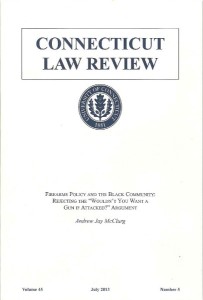 Andrew Jay McClurg, Firearms Policy and the Black Community: Rejecting the “Wouldn’t You Want a Gun If Attacked” Argument, 45 Connecticut Law Review 1773-1808 (2013). Andrew Jay McClurg, Firearms Policy and the Black Community: Rejecting the “Wouldn’t You Want a Gun If Attacked” Argument, 45 Connecticut Law Review 1773-1808 (2013).
The gun lobby has succeeded in focusing the gun debate on a narrow, oversimplified question: “If a criminal attacked you, wouldn’t you prefer to have a gun to protect yourself?” This article asserts that the question—which correlates with a “more guns” argument—is a red herring, a diversion that leads us off track and blinds us to the need for comprehensive strategies to address the complex, polycentric issues of gun violence in America.
In his article, Firearms Policy and the Black Community: An Assessment of the Modern Orthodoxy, Professor Nicholas Johnson pursues a version of the “Wouldn’t you want a gun if attacked?” argument particularized to black communities. Johnson uses the article as a platform for opposing black leaders who support gun regulation while essentially advocating for a “more guns” approach to violence in black communities.
This reply article highlights structural and rhetorical issues in Johnson’s arguments, but focuses on the reasoning fallacy inherent in concentrating the gun debate on a single, exaggerated utility of guns (i.e., the “Wouldn’t you want a gun if attacked?” argument) without fairly considering the offsetting risks or costs. It also asserts we should act quickly as a nation to invest in more research and data collection pertaining to the causes and prevention of firearms deaths and injuries, including the efficacy of guns for self-defense. Only with current, accurate information —which does not exist due in large part to efforts by the gun lobby to stifle gun research—can governments and individuals make rational firearms choices. The article concludes with a detour from the academic, theoretical world of gun debating to Memphis, Tennessee, one of America’s most violent cities.
December 11th, 2012 People sometimes (infrequently, slightly more often than “not ever”) ask how I got started writing legal humor.
It was a steaming summer afternoon back in 1995. I sat in my law school office sweating footnotes. Frustrated by the strictures of law review writing requiring that every sentence be documented in a–preferably lengthy–footnote, I snapped. Exiting the article, I dashed off The World’s Greatest Law Review Article, a heavily footnoted parody of real law review articles.
Not knowing what to do with it, I sent it to the American Bar Association Journal. They published it (Oct. 1995, pp. 84-85) and The World’s Greatest Law Review Article struck a chord. Someone spotted it posted on the wall of a law school in Hong Kong. A law review editor wrote to say, “Thank you for helping me make it through life.” A managing partner at the law firm I worked at before joining academia wrote, “I never realized you were mentally ill.”
The parody led to Harmless Error, my monthly column in the A.B.A. Journal.
Here’s how it all got started: The World’s Greatest Law Review Article (art by Wayne Slezak).
September 3rd, 2012 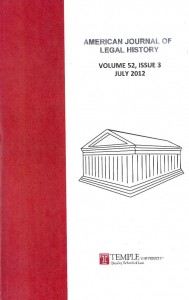 Andrew Jay McClurg, Book review: Philip K. Howard, Life Without Lawyers: Restoring Responsibility in America, 52 American Journal of Legal History 387 (2012). Andrew Jay McClurg, Book review: Philip K. Howard, Life Without Lawyers: Restoring Responsibility in America, 52 American Journal of Legal History 387 (2012).
Contrary to the title, Philip K. Howard’s Life Without Lawyers is not an anti-lawyer screed. It does not argue for a society without lawyers and suggests only in passing that America has too many lawyers. A more apt title would be “Life Without Rules” or maybe “Life Without Law.”
Howard argues that America’s enormous inventory of laws and bureaucratic rules is crippling society by making it impossible for people and institutions to do their jobs effectively. His opinion is that the primary reason is because they live in fear of potential legal consequences, making a case that the rights-explosion of the 1960s has led to a rights-obsessed, risk-averse culture that overvalues individual rights to the detriment of broader communitarian interests.
His principal solution is to grant judges and administrators more discretion to make decisions without the necessity of having a legally supportable record to back up their decisions.
This review contains some critique, but agrees with most of Howard’s general observations and concludes the book is a powerful one worth reading.
September 2nd, 2012  Fight Club: Doctors v. Lawyers, Chicago Medicine, June 2012, at 8 (cover story). Fight Club: Doctors v. Lawyers, Chicago Medicine, June 2012, at 8 (cover story).
This article, a shorter version of an article first published in the Temple Law Review, argues that doctors and lawyers have strong shared self-interests that should motivate them to improve their bitter relations, while offering several specific examples of ways to accomplish that goal.
Among other things, the article traces the history of medical malpractice litigation in the U.S. Did you know that the first reported medical malpractice case occurred in 1794 and that lawyers were first called sharks by doctors in 1878? Here’s an excerpt:
Relations between doctors and lawyers got off to a rocky start in the first reported U.S. medical malpractice case, Cross v. Guthery, decided by a Connecticut court in 1794. The defendant operated on the plaintiff’s wife to remove a breast. She died three hours after the surgery because, according to the court, the defendant “performed said operation in the most unskillful, ignorant and cruel manner.”
The jury awarded the plaintiff £40. One can imagine relations got frosty in the litigation when the defendant doctor asserted that the plaintiff wasn’t entitled to damages because he allegedly had agreed to settle the case for £15—which the doctor claimed the plaintiff owed him “for doctoring his wife.” The court rejected the defense and ruled for the plaintiff.
Medical malpractice lawsuits were rare when Cross was decided. Early on, some physicians actually embraced malpractice litigation as a way to cleanse their ranks of quacks and charlatans. At the time of the American Revolution, only 5 percent of the nation’s 3,500 medical practitioners had any type of medical degree. Relations soured, however, with a surge of lawsuits filed between 1840-50, a period denoted by James Mohr as the nation’s first “medical malpractice crisis.”
By 1860, a book review of an early treatise about medico-legal jurisprudence opined that “law and medicine had evolved into mutually incompatible professions.” Less restrained assessments of the relationship were abundant. As Mohr noted, “[i]t would be easy to fill several hundred pages full of vituperative, anti-legal rhetoric from medical journals after mid-century.”
The first reported unflattering comparison by doctors of lawyers to a certain ocean predator appeared around this time. In 1878 physician Eugene Sanger wrote that medical malpractice lawyers “follow us as the shark does the emigrant ship.” The epithet has enjoyed impressive staying power. A hundred years later, the president of the Association of American Medical Colleges told a graduating medical school class, “We’re swimming in shark-infested waters where the sharks are lawyers.”
The article argues that the two professions have a stronger self-interest in building up professions generally than in continuing to tear each other down.
February 1st, 2012 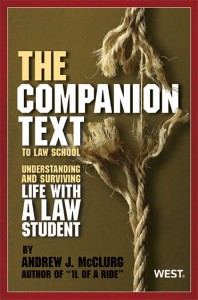 The “Companion Text” to Law School: Understanding and Surviving Life with a Law Student (West 2012) The “Companion Text” to Law School: Understanding and Surviving Life with a Law Student (West 2012)
Amazon.com listing
Table of Contents
As every lawyer and law student knows, law school is an adventure for the entire family. It’s a life-changing experience that affects everyone involved.
Dozens of books have been written to prepare students for law school, but what about all those other suffering souls–the relatives and friends who support and struggle right alongside the student on their wild and crazy journey toward a Juris Doctor degree? Who’s preparing them?
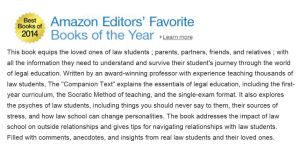 Named one of Amazon Editors’ Favorite Books of 2014. Read interview with McClurg about the book on the Westlaw Insider Blog
The “Companion Text” to Law School is designed to equip loved ones of law students—parents, partners, and other friends and relatives—with all the information and tools needed to understand both law school and their stressed out, rapidly transforming student.
Highlights
• Written by an award-winning professor with wide experience teaching thousands of law students at six law schools.
• Explains all the essentials of legal education, including the first-year curriculum, the Socratic Method of teaching, and the dreaded single-exam format.
• Explores the psyches of law students, including what they love to talk about, things you should never say to them, their sources of stress, and how law school can change their personalities.
• Addresses the impact of law school on outside relationships—and vice versa—and gives tips for navigating relationships with law students.
• Includes dozens of comments, anecdotes, and insights from real law students and their loved ones.
• Extras include a chapter on the types of jobs available to new law graduates, fun “legal” questions you can use to stump your student, a sample case, and a glossary.
• Backed up throughout by academic research.
• Written in a lively, reader-friendly voice, bolstered by humor.
November 16th, 2011 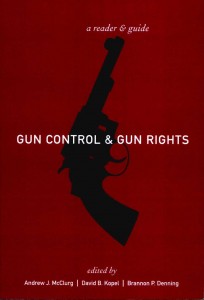 Gun Control and Gun Rights (N.Y.U. Press 2002) (with David B. Kopel & Brannon P. Denning) Gun Control and Gun Rights (N.Y.U. Press 2002) (with David B. Kopel & Brannon P. Denning)
Amazon.com listing
Most firearms policy discourse falls firmly on one side of the debate or the other. Showcasing viewpoints from all sides of the gun control debate, Gun Control and Gun Rights offers the first (and still the only) balanced firearms law and policy book. Anyone looking for a fair, even-handed account of the gun issue will find it in this book.
Review Excerpts:
“Most academic literature regarding firearms policy is one-sided advocacy scholarship. … This book seeks to create … a balance.” — Future Survey
“For the most part, the gun-policy debate in the United States could be well summed up by Yeats’ words: The best lack all conviction, while the worst are full of passionate intensity. Truly honest scholarship … has been sorely lacking. … No one, it seems, has come forward to frame the questions that the debate ought to be seeking to answer. Andrew McClurg, David Kopel, and Brannon Denning have done just that.” — Amazon.com Customer Review
“[Any book by Brannon Denning,] Andrew McClurg, and David Kopel is bound to be a major—and more importantly an honest and balanced—contribution to the great American gun debate. Both Kopel and McClurg are fastidious scholars who are able to bring to this work the best of both sides.” — Barnes & Nobel.com Customer Review
November 16th, 2011 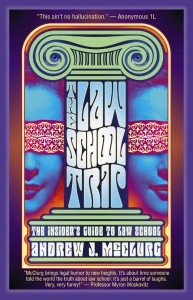
The Law School Trip: The Insider’s Guide to Law School (Trafford 2001)
Amazon.com listing
The Law School Trip, a satire of legal education, gives the complete inside story on: The LSAT® and Other Registered Trademarks, How to Survive the Socratic Method with Treatable Injuries, Learning to Love Mrs. Palsgraf, Fun, Fun, Fun and the Rule Against Perpetuities, Strange Creatures from Outer Space and Other Law Professors, Law’s Greatest Hits: Best First-Year Cases, and more.
Review excerpts:
“Laughter is what McClurg’s book provides. Lots of laughter. Heaps and mounds of undulating and ululating laughter. … McClurg makes the law school experience sparkle and shine. He has the unique ability among satirists to make us laugh with each other, but never at each other.” — The Law Teacher
“[T]he quintessential book on the three years oftorment and tribulation known as law school. … [H]owlingly, gut-wrenchingly, turn purple and blow food out your nose funny! … [S]hould be required reading for every law student and lawyer.” — The Bimonthly Review of Law Books
”McClurg has the ability to take excruciating situations, turn them around, and make them funny. He laughs at everything, including himself, but retains a reverence for the legal profession that is poignant. It is a gut-busting good time that leaves you proud of your chosen profession and makes your sides ache at the same time.” — The Opinion
“Dispense[s] buckets of advice without ever removing tongue from cheek. … a ‘loving parody’ from the eyes of one who knows.” — The National Jurist, The Magazine for Law Students
“Professor McClurg may be the next Dave Barry. … McClurg’s unique outlook on law school life is guaranteed to make you to make you laugh out loud. Five stars and two thumbs up!” — WorldJustice.com
“[T]akes the sting right out of the high-handed pomposity, the double-talk, and officious seriousness of our legal training institutions … [A] barrel of screwy fun … [A] one of a kind piece of work that you don’t have to be a lawyer or law student to love.” — Text-Book.com
“If your smart bone is connected to your funny bone, there’s only one book for you: Andrew McClurg’s The Law School Trip. It left me holding my sides while thinking: wait! I never thought about that before! This is serious! This book gave me more pure pleasure than anything I’ve read in months.” — Professor Marianne Wesson, bestselling author of Render Up the Body and A Suggestion of Death
“A wonderful, twisted tour through legal education that had me laughing all the way. … [T]he perfect antidote for legal education … [A] must read for law students, professors and lawyers.” — Professor Gerry Hess, Gonzaga University
“Hard to find words to describe it. Spectabulous? Fanacular? McClurg brings legal humor to new heights. … Very, very funny!” — Professor Myron Moskovitz, Golden Gate University
What a ‘Trip’! Hilariously poking fun at law students, professors, judges, and the law itself, Andrew McClurg’s The Law School Trip is truly a classic of legal humor.” — Professor David G. Owen
“A delicious read from beginning to end.” — Grif Stockley, bestselling author of Probable Cause and Religious Conviction
“You’ll howl with delight … chortle uncontrollably … your funny bone will ache.” — Professor Timothy R. Zinnecker
“There is no doubt that this creative and amusing masterpiece will be a classic. You will feel the need to share excerpts with friends, then they will borrow the book and never return it!” — Amazon.com customer review (Cherish L. Cronmiller)
“There was not a single page of this book that didn’t make me laugh out loud.” — Amazon.com customer review (Jacquie Brennan)
November 16th, 2011 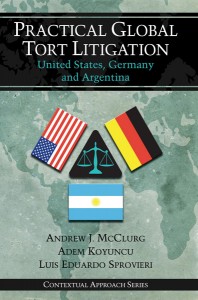
Practical Global Tort Litigation: United States, Germany and Argentina (Carolina Academic Press 2007) (with Adem Koyuncu and Luis Sprovieri)
Amazon.com listing
Publisher’s listing
Practical Global Tort Litigation is the first entry in The Contextual Approach Series to comparative law, which McClurg conceived while a professor at Florida International University College of Law. The series, for which McClurg serves as editor, is intended to show how the law “really works” in different nations by following hypothetical cases in different subject areas from beginning to completion. The books are designed to “show” instead of just “tell.”
Practical Global Tort Litigation takes readers on a journey through a products liability case in the United States, Germany, and Argentina. Using a shattering glass food container as the vehicle, the book compares how a prototypical products liability case would be handled in the U.S. common law system and representative civil law nations in Europe and Latin America. The book analyzes from a real world perspective issues such as fact gathering and presentation, expert witnesses, burdens of proof, theories of recovery and defenses, and damages and attorneys’ fees.
Review Excerpts:
“McClurg, Koyuncu, and Sprovieri have produced the blueprint for academics interested in examining comparative approaches to the law.” — Ediberto Román, Professor of Law, Florida International University
“It is impossible to conceive of a more creative, effective, or engaging way to get one’s arms around the fascinating if unwieldy issues of comparative law than to examine through separate lenses how a particular lawsuit would be handled under such disparate legal systems, reflecting such differing cultural traditions.” — David G. Owen, Carolina Distinguished Professor of Law, University of South Carolina
“The unique focus on a single case permits three different legal systems to be compared effectively and efficiently. The brisk and accessible style makes it perfect for classroom use, although lawyers outside of the academy will find it worth reading for the sheer intrinsic pleasure of learning about how familiar concepts are handled elsewhere.” — Anthony J. Sebok, Centennial Professor of Law, Brooklyn Law School
November 15th, 2011 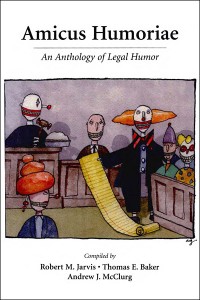
Amicus Humoriae (Carolina Academic Press 2003)
Amazon.com listing
The co-editors–law professors Robert M. Jarvis, Thomas E. Baker, and Andrew J. McClurg– collect twenty-five of the funniest law review articles from the past fifty years, arranged in five categories: law students, law professors, lawyers, judges, and legal scholarship. Who says law journal articles have to be stuffy and boring? An “intelligent gift” for lawyers, filled with outstanding writing and sophsticated wit.
Review Excepts
“A collect[ion] of rare gems.” — The Green Bag
“A very funny romp through legal life.” — The National Law Journal
“Definitely a good read.” — The National Jurist
“[S]plendid examples of the seriously underdeveloped genre of law review humor writing.” — Legal Times
November 14th, 2011 Andrew Jay McClurg, Fixing the Broken Windows of Online Privacy Through Private Ordering: A Facebook Application, 1 Wake Forest Law Review Online 74 (2011).
Building on a growing body of contract-based privacy scholarship, Professor Patricia Sánchez Abril has advanced a creative, concededly ambitious proposal for people to privately order their online interpersonal privacy: a system of standardized click-wrap-type confidentiality agreements in which social network users would be required to accept a content provider’s personal privacy preferences to access their online information.
The contracts would be legally binding, enforceable through traditional means, although Abril suggests that most breaches would be minor and could be addressed by a self-policed online complaint and perhaps eBay-type rating system administered by the social network host.
This reply to Abril’s article imagines how her proposal might function, or be adapted to function, in a real-world context, using Facebook as an example. Abril’s proposal is not limited to Facebook, but it is focused on online social networks.
The omnipresent force that is Facebook comes readily to mind when reading her article. With more than 500 million members as of 2010, Facebook is the undisputed heavyweight world champion of personal information-sharing. If any single entity holds the power to change the context of online social network privacy, it’s Facebook. Thinking about how Abril’s proposal might work with Facebook highlights some obstacles to it, but also illustrates the great potential of her ideas.
In the end, using Abril’s idea, the author suggests that Facebook could significantly alter the context of online privacy even without binding contracts, through a system of simple non-binding user-privacy preference icons (linked to short descriptions) that would run with all posted content.
November 13th, 2011 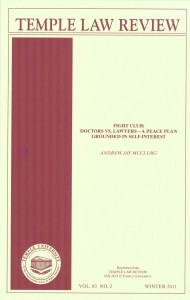 Andrew Jay McClurg, Fight Club: Doctors vs. Lawyers―A Peace Plan Grounded in Self Interest, 83 Temple Law Review 101-58 (2011). Andrew Jay McClurg, Fight Club: Doctors vs. Lawyers―A Peace Plan Grounded in Self Interest, 83 Temple Law Review 101-58 (2011).
Doctors and lawyers have been at odds since the first medical malpractice “crisis” occurred in the mid-nineteenth century. As one professor said, it is axiomatic these days that “doctors hate lawyers,” which is curious in one sense given that social psychology “liking” research suggests they should get along well in light of their similar backgrounds and socioeconomic status.
Their modern fight plays out publicly in a variety of forums, principally the national tort reform movement. Like professional wrestlers, the fighters sometimes resort to dirty tactics. It is an unseemly, embarrassing spectacle for what traditionally have been considered the two most prestigious professions. Given the importance of the healthcare and legal systems they serve, the doctor-lawyer conflict has implications for all Americans. Previous calls for doctors and lawyers to improve their relationship have been met with scorn.
This article takes a different tack in calling for improved relations: an appeal to self-interest. It argues that doctors and lawyers have shared tangible and intangible interests in reducing their conflict and improving communication. The article also sets forth several steps toward accomplishing those goals, including the need for each side to acknowledge certain core, uncomfortable truths about our medical liability system. It begins with a brief history of the doctor-lawyer fight and an explanation of why the two groups dislike each other so much.
Throughout, doctors and lawyers are compared on a variety of measuring scales such as total numbers, educational debt load, income, public approval ratings, jokes concerning, job satisfaction, political leanings, substance abuse, and suicide rates.
November 13th, 2011 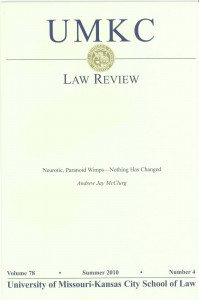 Andrew Jay McClurg, Neurotic, Paranoid Wimps―Nothing has Changed, 78 University of Missouri-Kansas City Law Review 1049-61 (2010). Andrew Jay McClurg, Neurotic, Paranoid Wimps―Nothing has Changed, 78 University of Missouri-Kansas City Law Review 1049-61 (2010).
In an issue of the UMKC Law Review devoted to “1L Stories” and intended as a tribute to Scott Turow’s classic book, One L, the author recounts his own first-year tales of neurotic, paranoid wimpism (descriptors from Amazon.com reviews of Turow’s book). Turow wrote the foreword for the issue.
The author’s narrative asserts that a dominant theme of One L, the story of Turow’s first year at Harvard Law School, was negative affect. Turow talked of anxiety, fear, stress, panic, vulnerability, self-doubt, shame and grief, wounded self-esteem, unhappiness, paranoia, embarrassment, oppression, and insanity.
The author describes his similar experiences and asserts that, contrary to popular belief, things have not changed that much in legal education since his and Turow’s day.
November 13th, 2011 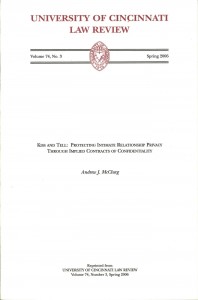 Andrew J. McClurg, Kiss and Tell: Protecting Intimate Relationship Privacy Through Implied Contracts of Confidentiality, 74 University of Cincinnati Law Review 887-940 (2006). Andrew J. McClurg, Kiss and Tell: Protecting Intimate Relationship Privacy Through Implied Contracts of Confidentiality, 74 University of Cincinnati Law Review 887-940 (2006).
In today’s tell-all world, where anyone with internet access can become a “media outlet,” growing numbers of people are finding themselves the victims of former intimate partners who mass disseminate private, highly embarrassing information, including photos and videotapes, about or involving them.
In theory, tort law provides the perfect (and exclusive) remedy when one gives widespread publicity to embarrassing, non-newsworthy private facts about a person in a manner that reasonable persons would consider highly offensive. In practice, however, this claim—known as the tort of “public disclosure of private facts”—offers virtually no chance of recovery by plaintiffs. The tort sustained severe, possibly mortal wounds in a series of U.S. Supreme Court cases culminating in Florida Star v. B.J.F. (1989). In its current formulation, it is quite possible that the public disclosure tort is unconstitutional under the First Amendment.
The demise of the public disclosure tort has left a large gap in privacy protection for victims of offensive disclosures of private information. This Article proposes a theory to partially fill that gap in some public disclosure situations arising from intimate relationships. Specifically, expanding on an argument advanced by Professor Eugene Volokh that the only constitutionally permissible means for enforcing personal information privacy is contract law, the article argues that an implied contract of confidentiality arises in intimate relationships that the parties will not disseminate through an instrument of mass communication private, embarrassing information about the other acquired during the relationship.
November 13th, 2011 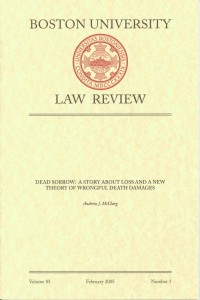 Andrew J. McClurg, Dead Sorrow: A Story About Loss and A New Theory of Wrongful Death Damages, 85 Boston University Law Review 1-51 (2005). Andrew J. McClurg, Dead Sorrow: A Story About Loss and A New Theory of Wrongful Death Damages, 85 Boston University Law Review 1-51 (2005).
This “scholarative”–combining personal narrative and traditional doctrinal scholarship–tells the story of a personal loss as a prelude for arguing for a new theory of wrongful death damages.
When a tortiously caused death occurs, five losses/injuries result: (1) the decedent’s life itself; (2) the trauma and bereavement suffered by the decedent’s survivors, collectively referred to in this article as “grief;” (3) the pecuniary value of financial and service contributions that the decedent could have been expected to make to his or her dependents; (4) the loss of the decedent’s society and companionship, which in some states is considered a type of pecuniary loss under the fiction that society and companionship are a type of “lost service” with ascertainable monetary value (technically placing such damages in category 3) but which in other states is viewed as an intangible or noneconomic loss; and (5) the direct costs associated with the death, such as funeral expenses.
The wrongful death system fails to account for the first two elements. Current law attaches no monetary value to life itself. The second item, grief, traditionally has been the invisible injury from wrongful death. This article proposes a legislative reconceptualization of wrongful death damages that addresses both of the deficiencies described above—for one price. Specifically, it argues that life has independent value apart from what we earn and give to others and that this value should be recognized in the form of “lost life” damages.
Departing from the orthodox view that such damages should be allocated to the decedent’s estate or to the survivors, the article instead suggests that damages for the lost value of life be used for the exclusive purpose of establishing a lasting memorial to the decedent. Such a solution would promote both the economic deterrence and corrective justice models of tort law.
Additionally, the memorial established with the lost life damages would, at no additional cost, provide a proven grief-healing instrument for all persons who mourn the decedent’s passing. Finally, because it is recommended that memorials created with lost life damages be required to serve a utilitarian function, another unique aspect of the proposal is that it would allocate tort damages in ways that benefit society in addition to tort victims, enhancing the net social benefit of the tort system.
November 13th, 2011 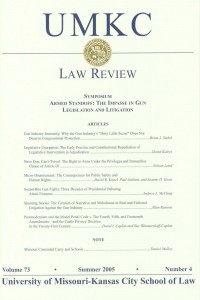 Andrew J. McClurg, Sound-Bite Gun Fights: Three Decades of Presidential Debating About Firearms, 73 University of Missouri-Kansas City Law Review 1015-45 (2005). Andrew J. McClurg, Sound-Bite Gun Fights: Three Decades of Presidential Debating About Firearms, 73 University of Missouri-Kansas City Law Review 1015-45 (2005).
In recent years, both major political parties have shied away from discussing gun control and gun rights during the presidential election cycle.
But it wasn’t always been that way. To the contrary, with all of the important issues affecting America and Americans—taxes, budget deficits, foreign policy, unemployment, abortion, energy policy, the environment, education, poverty, health care, terrorism, Social Security and Medicare, nuclear disarmament and proliferation, tort reform, big government, equal rights and others—gun control has been one of the most frequently asked-about subjects over the twenty-eight year period of presidential debating from 1976-2004. The issue formed the subject of specific debate questions in five of the nine presidential debate cycles during that period.
This essay explores how presidential candidates performed in the gun debate during that period on the biggest political stage of them all.
It reviews, largely from a rhetorical perspective, the presidential debates from 1976 to 2004 through the lens of firearms policy, collecting and commenting on each excerpt from the debates pertaining to gun rights and gun control.
November 13th, 2011  Andrew J. McClurg, Book Review: Joyce Lee Malcolm, Guns and Violence: The English Experience, 47 American Journal of Legal History 507 (2004). Andrew J. McClurg, Book Review: Joyce Lee Malcolm, Guns and Violence: The English Experience, 47 American Journal of Legal History 507 (2004).
Joyce Lee Malcolm’s Guns and Violence: The English Experience offers both an interesting history of guns and gun laws in England and a policy polemic that attempts to establish, through the English experience, that strict gun laws do not reduce violent crime. As explained in this book review, Malcolm’s book succeeds better as history than as advocacy.
Malcolm took on a big challenge in attempting to trace the history of guns and crime in England from medieval times to the present. She pulled it off admirably, constructing a cohesive survey of importance not only to historians, but to anyone interested in firearms policy.
The weakness of the book lies in Malcolm’s attempt to go one big step further and argue–with insufficient data and too many variables to account for over a period of several hundred years–that gun restrictions in England have led to increased crime, rather than, as gun control advocates assert, less crime (or at least, less violent crime).
November 12th, 2011 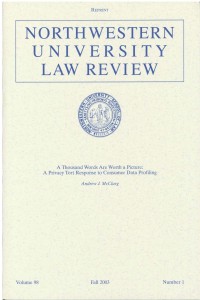 Andrew J. McClurg, A Thousand Words Are Worth a Picture: A Privacy Tort Response to Consumer Data Profiling, 98 Northwestern University Law Review 63-144 (2003). Andrew J. McClurg, A Thousand Words Are Worth a Picture: A Privacy Tort Response to Consumer Data Profiling, 98 Northwestern University Law Review 63-144 (2003).
Private companies collect and aggregate thousands of items of information about individual consumers with a view toward compiling a “complete 360-degree view” of a consumer’s life. Concerns over shrinking privacy in a data-driven economy have prompted several ingenious proposals from scholars to regulate the field of information privacy.
This article discusses each of those approaches, including the potentially insurmountable obstacles they face, and opts for a tort response to invasive consumer data profiling. Specifically, it argues that collecting and selling an extensive consumer data profile without consumer consent should be actionable under the privacy tort known as appropriation. The appropriation tort provides for liability against one who appropriates the identity of another for his own benefit, which is nearly always commercial in nature.
In modern times, appropriation is wielded almost exclusively by celebrities as a weapon for protecting the value of their fame, often under the rubric of the “right of publicity.” Most successful appropriation cases involve situations where the defendant has, without consent, used some aspect of a celebrity’s physical likeness, such as a picture or drawing, to promote its product or service.
The article asserts that the appropriation tort, both as originally conceived and as reflected in the reasoning of modern cases and influential secondary authorities, is aimed at protecting a broader sphere of identity than mere names or physical likenesses. It also asserts that, unlike the property-based right of publicity action with which it is often confused, the appropriation tort was created to protect dignitary rather than economic interests.
November 12th, 2011 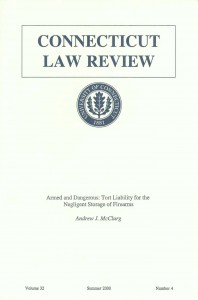 Andrew J. McClurg, Armed and Dangerous: Tort Liability for the Negligent Storage of Firearms, 32 Connecticut Law Review 1189-1245 (2000). Andrew J. McClurg, Armed and Dangerous: Tort Liability for the Negligent Storage of Firearms, 32 Connecticut Law Review 1189-1245 (2000).
Overwhelming evidence shows that high percentages of American gun owners negligently store their firearms, leaving them easily accessible to unauthorized, dangerous users. Public health studies show that millions of guns are kept loaded and unlocked. More than 50 percent of all handguns are stored unlocked. Ammunition is stored unlocked in between 30–40 percent of gun-owning households. Millions of children live in homes with loaded, unlocked firearms.
The author has argued in other articles for safe gun storage laws as a way to reduce accidental shootings, adolescent suicides, and intentional third-party shootings tied to stolen guns. This article makes a case that unsafe firearm storage constitutes an unreasonable risk and is negligent conduct under universally accepted principles of tort law.
November 12th, 2011 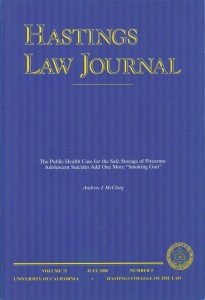 Andrew J. McClurg, The Public Health Case for the Safe Storage of Firearms: Adolescent Suicides Add One More ‘Smoking Gun’, 51 Hastings Law Journal 953-1001 (2000). Andrew J. McClurg, The Public Health Case for the Safe Storage of Firearms: Adolescent Suicides Add One More ‘Smoking Gun’, 51 Hastings Law Journal 953-1001 (2000).
This article argues for passage of safe gun storage laws as a means of reducing adolescent suicides.
Millions of loaded and unlocked firearms sit in homes throughout America, easily accessible to unauthorized, dangerous users. Public health research, including ten studies discussed in this Article, shows that astonishingly high percentages of gun owners negligently store the most dangerous consumer product legally obtainable. Unsecured guns invite firearms tragedies of all types.
The author has previously argued for safe gun storage laws as a means for reducing both accidental and intentional third-party shootings.
The current article asserts that legislatively mandated safe firearms storage would also help stem the tide of adolescent suicide. Suicide is the second leading cause of death among youths between the ages of fifteen and nineteen, and the third leading cause of death for youths aged fifteen to twenty-four. While the overall suicide rate in the United States has remained relatively stable since 1950, the rate of suicide for adolescents has more than tripled. Firearms account for 60 percent of all suicides in this country, including youth suicides, even though they are used in only a small percentage of suicide attempts.
November 12th, 2011 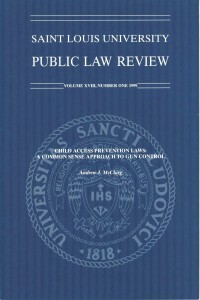 Andrew J. McClurg, Child Access Prevention Laws: A Common Sense Approach to Gun Control, 18 St. Louis University Public Law Review 47-78 (1999). Andrew J. McClurg, Child Access Prevention Laws: A Common Sense Approach to Gun Control, 18 St. Louis University Public Law Review 47-78 (1999).
Fifteen states have Child Access Prevention or “CAP” laws that make it a crime for a gun owner to store a loaded firearm in a manner in which he knows or reasonably should know a child may gain access to the weapon.
This article asserts that CAP laws are a reasonable and feasible way to reduce a variety of gun-related harms. CAP laws do not constitute “gun confiscation” or, as a newspaper editorial asserted, “a cynical attempt to cancel a constitutionally guaranteed right.”
Basically, a CAP law says to gun owners: You own a dangerous instrumentality that can be used to instantly end a human life. You must store it in a reasonably safe way. If you fail to do so and a child or other unauthorized user gains possession of it and uses it to inflict harm, you will be held responsible.
Although CAP laws are touted primarily as a means of reducing accidental shootings by children, they also can be expected to prevent some intentional third-party shootings and suicides. When guns are securely stored, they cannot be misused by unauthorized users.
November 11th, 2011 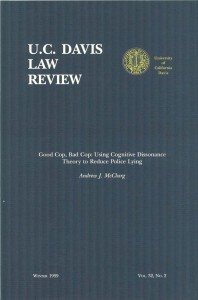 Andrew J. McClurg, Good Cop, Bad Cop: Using Cognitive Dissonance Theory to Reduce Police Lying, 32 University of California-Davis Law Review 389-453 (1999). Andrew J. McClurg, Good Cop, Bad Cop: Using Cognitive Dissonance Theory to Reduce Police Lying, 32 University of California-Davis Law Review 389-453 (1999).
This article argues that lessons from the social psychology field of cognitive dissonance theory can be applied to create a successful police integrity training and mentoring program, one that matches rookie officers with cadets still in training at the police academy as a way to perpetuate honesty as an intrinsic police value and prevent good cops from turning bad.
Cognitive dissonance is the tension that arises when one holds two conflicting beliefs or believes one way and then acts another. Dissonance is strongest when it involves a cognition about the self and behavior that violates that self-concept. Self-concept theory rests on the assumption that humans strive to maintain consistency between their own high concept of themselves, including their moral self-concept, and their behavior.
If a person considers herself to be a moral person and commits an immoral act, she will experience dissonance. Reducing this dissonance will require her to rethink or justify her actions to make them more consistent with her self-concept by changing attitudes or behavior. Because it directly challenges a person’s image of herself, dissonance-based persuasion is a powerful behavior-altering force. Dissonance persuasion has been used successfully to change attitudes and behavior about energy conservation, condom use for AIDS prevention, weight reduction, and adolescent smoking.
McClurg articulates a framework for police integrity programs based on the sponsorship model used effectively in 12-step recovery programs such as Alcoholics Anonymous. The sponsorship model works because it—perhaps unwittingly–capitalizes on the power of cognitive dissonance theory.
November 11th, 2011 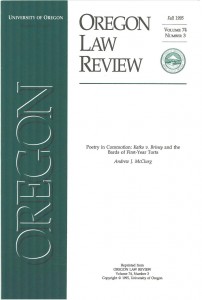 Andrew J. McClurg, Poetry in Commotion: Katko v. Briney and the Bards of First-Year Torts, 74 Oregon Law Review 823-48 (1995). Andrew J. McClurg, Poetry in Commotion: Katko v. Briney and the Bards of First-Year Torts, 74 Oregon Law Review 823-48 (1995).
A classroom incident involving Katko v. Briney, the famous Iowa “spring-gun case,” started the author thinking about the suffocating environment legal education imposes on original expression.
Law school offers virtually no outlets for creativity, which is curious given the substantial reservoir of brain power collected in law schools and the fact that good lawyers must be creative thinkers. Students generally have only two avenues for expressing themselves within the institutional framework: their classroom comments and their written products.
Many law professors like to believe they foster a dynamic, vibrant classroom learning environment, but it is easy to confuse a successful bag of teaching tricks with vibrancy. True vibrancy requires risk-taking, spontaneity, inconsistency in presentation, and a relaxed freedom to speak openly—but these ingredients are missing from most law school classes.
The author’s one-percent solution (a mere footnote to a brainstorm) was to require his Torts students to compose poetry instead of case briefs about Katko, with surprising, satisfying results. The students’ poems make up much of this essay.
November 11th, 2011 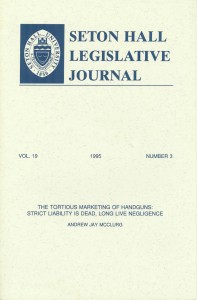 Andrew Jay McClurg, The Tortious Marketing of Handguns: Strict Liability is Dead, Long Live Negligence, 19 Seton Hall Legislative Journal 777-820 (1995). Andrew Jay McClurg, The Tortious Marketing of Handguns: Strict Liability is Dead, Long Live Negligence, 19 Seton Hall Legislative Journal 777-820 (1995).
The author is credited by legal scholars for helping create the tort theory of “negligent marketing” claims against handgun manufacturers. In this article, arguing that strict liability was a failed theory, he asserts that victims of gun violence should refocus their sights on the more prosaic liability theory of common law negligence. In his words, it is time to “go back to basics.”
The article advances three different negligent marketing theories for suing handgun manufacturers: (1) negligence in marketing unusually dangerous weapons such as assault weapons and Saturday Night Special-type handguns; (2) negligence in promoting the sale of handguns to criminal consumers; and (3) negligence in failing to take reasonable precautions to minimize the risk of handguns being sold to those likely to misuse them. The strengths and weaknesses of each theory are extensively analyzed.
November 10th, 2011 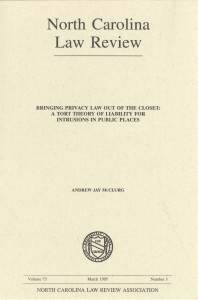 Andrew Jay McClurg, Bringing Privacy Law Out of the Closet: A Tort Theory of Liability for Intrusions in Public Places, 73 North Carolina Law Review 989-1088 (1995). Andrew Jay McClurg, Bringing Privacy Law Out of the Closet: A Tort Theory of Liability for Intrusions in Public Places, 73 North Carolina Law Review 989-1088 (1995).
“Public privacy” sounds like an oxymoron, but this article asserts a tort theory to enforce just such a right under limited circumstances. Traditionally, courts have refused to recognize a right to privacy in a public place. The author argues that this lack of protection needs to be revisited in a world where good taste and decency have vanished from journalism/entertainment and video cameras and other electronic privacy-invading devices have proliferated.
Analyzing the three foundations of privacy—secrecy, solitude, and anonymity—the author explains how and why they need, and are worthy of, legal protection even in some public contexts.
Specifically, he proposes a redefinition of the privacy tort known as “intrusion” (as incorporated in the Restatement (Second) of Torts) that would allow recovery for highly offensive instances of intrusions in public places. He enlists a multi-factor test to assess the offensiveness of intrusive conduct, a standard that balances privacy interests against the countervailing interests of free social interaction and speech.
November 10th, 2011 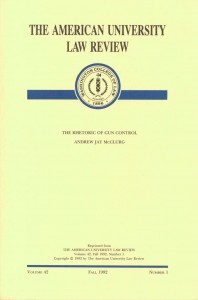 Andrew J. McClurg, The Rhetoric of Gun Control, 42 American University Law Review 53-113 (1992). Andrew J. McClurg, The Rhetoric of Gun Control, 42 American University Law Review 53-113 (1992).
In a democratic, pluralistic society, action on any issue of social importance depends on acceptance of the action by many different audiences. Acceptance depends on the audiences being persuaded as to the rightness of the action. Persuasion depends on effective rhetoric.
Unfortunately, effective rhetoric is often fallacious and logically defective. A fallacy is a type of incorrect argument, and the study of fallacies is a sub-species of logic. A fallacious argument is one that appears to be correct and which may be very persuasive, but which proves on closer examination to be logically invalid.
In this article, the author asserts that fallacious argument dominates the gun control and gun rights debate on both sides. The author identifies and explains many specific examples of fallacious reasoning and argument in the gun debate, including fallacies of emotion, fallacies of diversion, and fallacies of proof.
November 10th, 2011 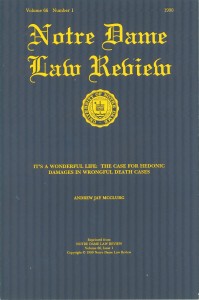 Andrew Jay McClurg, It’s a Wonderful Life: The Case for Hedonic Damages in Wrongful Death Cases, 66 Notre Dame Law Review 57-116 (1990). Andrew Jay McClurg, It’s a Wonderful Life: The Case for Hedonic Damages in Wrongful Death Cases, 66 Notre Dame Law Review 57-116 (1990).
What is a human life worth? The philosophical answer, echoed in literature throughout the ages, is that life is priceless. The answer under the American tort system is “zero.”
“Patient dumping” is medical non-practice. Patient dumping involves hospital refusing to provide emergency care to patients because of their inability to pay. Instead of receiving treatment, the indigent, uninsured patient is turned away or shuffled across town to the nearest public hospital. The latter practice is euphemistically referred to as an “economic transfer.”
In 1986, Congress gave victims of patient-dumping a weapon with which to fight back: a provision of the Consolidated Omnibus Budget Reconciliation Act of 1986 (COBRA) creating a private right of action to patients who have been refused emergency care. Your Money or Your Life, widely cited by courts as well as legal commentators, was the first law review article seeking to interpret the Act. The article examines numerous sources of interpretation, including the statutory language, legislative history both before and after enactment, federal regulations proposed to implement portions of the Act, analogies drawn from general tort principles and other remedial statutory schemes, and the policies sought to be furthered by the anti-dumping legislation.
The article begins by reviewing the scope of and reasons for the patient-dumping problem, and the inadequacy of available state law remedies to victimized patients.
November 10th, 2011 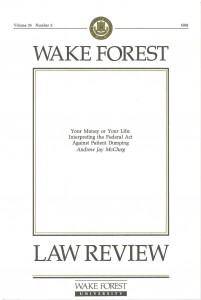 Andrew Jay McClurg, Your Money or Your Life: Interpreting the Federal Act Against Patient Dumping, 24 Wake Forest Law Review 173-237 (1989). Andrew Jay McClurg, Your Money or Your Life: Interpreting the Federal Act Against Patient Dumping, 24 Wake Forest Law Review 173-237 (1989).
“Patient dumping” is the world of medical non-practice: hospitals, usually private hospitals, refusing to treat patients in need of emergency care because of their inability to pay. Instead of receiving treatment, the indigent, uninsured patient is turned away or shuffled across town to the nearest public hospital. The latter practice is euphemistically referred to as an “economic transfer.”
In 1986, Congress gave victims of patient-dumping a weapon with which to fight back: a provision of the Consolidated Omnibus Budget Reconciliation Act of 1986 (COBRA) creating a private right of action to patients who have been refused emergency care. Your Money of Your Life, which has been widely cited by courts as well as legal commentators, was one of the first law review articles seeking to interpret the Act. The article examines numerous sources of interpretation, including the statutory language, the legislative history both before and after enactment, federal regulations proposed to implement portions of the Act, analogies drawn from general tort principles and other remedial statutory schemes, and the policies sought to be furthered by the anti-dumping legislation.
The article begins by reviewing the scope of the patient-dumping problem, the reasons for the problem, and state law remedies available to victimized patients.
November 8th, 2011 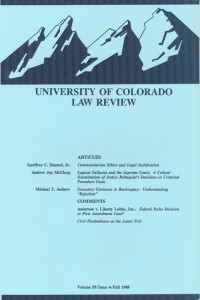 Andrew Jay McClurg, Logical Fallacies and the Supreme Court: A Critical Examination of Justice Rehnquist’s Decisions in Criminal Procedure Cases, 59 University of Colorado Law Review 741-844 (1988). Andrew Jay McClurg, Logical Fallacies and the Supreme Court: A Critical Examination of Justice Rehnquist’s Decisions in Criminal Procedure Cases, 59 University of Colorado Law Review 741-844 (1988).
Using former U.S. Supreme Court Chief Justice William H. Rehnquist’s opinions in criminal procedures cases as a contextual showcase, the author explores the nature and extent to which even U.S. Supreme Court justices, members of the world’s most powerful tribunal, resort to regularly employing rhetorical tricks and otherwise logically fallacious reasoning in their opinion-writing.
A logical fallacy is a type of incorrect argument, and the study of fallacies is a sub-species of logic. A fallacious argument is one that appears to be correct and which may be very persuasive, but which proves on closer examination to be logically invalid. Examples range from the familiar (e.g., begging the question, straw man arguments) to the esoteric (e.g., ignoratio elenchi, undistributed middle term).
This article, which has been assigned as required reading at national judicial conferences, examines more than twenty categories of both formal and informal logical fallacies and applies them to Justice Rehnquist’s criminal procedure opinions as concrete examples of how “crooked thinking” permeates persuasive writing even at its highest level of sophistication.
|
Funny Law School Stories
For all its terror and tedium, law school can be a hilarious place. Everyone has a funny law school story. What’s your story?
|
Product Warning Labels
A variety of warning labels, some good, some silly and some just really odd. If you come encounter a funny or interesting product warning label, please send it along.
|
Tortland

Tortland collects interesting tort cases, warning labels, and photos of potential torts. Raise risk awareness. Play "Spot the Tort." |
Weird Patents
Think it’s really hard to get a patent? Think again.
|
Legal Oddities
From the simply curious to the downright bizarre, a collection of amusing law-related artifacts.
|
Spot the Tort
Have fun and make the world a safer place. Send in pictures of dangerous conditions you stumble upon (figuratively only, we hope) out there in Tortland.
|
Legal Education
Collecting any and all amusing tidbits related to legal education.
|
Harmless Error
McClurg's twisted legal humor column ran for more than four years
in the American Bar Association Journal.
|
|
|
 McClurg’s fifth novel, Funeral Daze, under his pen name Dorian Box, is out and getting terrific reviews. Check it out on Amazon.
McClurg’s fifth novel, Funeral Daze, under his pen name Dorian Box, is out and getting terrific reviews. Check it out on Amazon. After two years of extensive research that included interviewing more than 150 lawyers, my new book (with coauthors Chris Coughlin and Nancy Levit),
After two years of extensive research that included interviewing more than 150 lawyers, my new book (with coauthors Chris Coughlin and Nancy Levit),  1L of a Ride: A Well-Traveled Professor’s Roadmap to Success in the First Year of Law School (West 4th ed. 2021)
1L of a Ride: A Well-Traveled Professor’s Roadmap to Success in the First Year of Law School (West 4th ed. 2021)

















 Andrew J. McClurg,
Andrew J. McClurg, 













